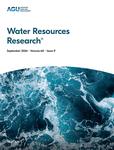Model Diagnostic Analysis in a Cold Basin Influenced by Frozen Soils With the Aid of Stable Isotope
Nan, Yi , Tian, Fuqiang , Li, Zongxing
2024 WATER RESOURCES RESEARCH null 60(卷), null(期), (null页)
Understanding the hydrological processes on the Tibetan Plateau (TP) under climate change is an important scientific question. The frequent multiphase transfer exacerbates the complexity of hydrological processes on the TP, which brings equifinality problem to hydrological models and causes large uncertainties in quantifying the contributions of runoff components. Tracer-aided hydrological models are helpful for improving model performances and have been adopted in cryospheric regions, but the influence of frozen soil has yet to be considered. This study adopted the Tracer-aided Tsinghua Representative Elementary Watershed model (THREW-T) in a typical cold basin with widespread frozen soil on the TP. The model structure was diagnosed with isotope by identifying the influences of frozen soil. A simplified catchment-scale frozen soil module was incorporated into the model. Results showed that: (a) The THREW-T model cannot simultaneously simulate baseflow and stream water isotope well. The imbalance of simulations on two objectives could be attributed to the influence of frozen soil, resulting in seasonal variation of soil-related parameters, which was not considered in the model. (b) Incorporating the frozen soil module significantly improved the balance of baseflow and isotope simulation, simultaneously producing low baseflow and high contribution of subsurface runoff during wet seasons. (c) The frozen soil had little influence on the annual streamflow, but changed the runoff seasonality by reducing baseflow during dry seasons and increasing subsurface runoff during wet seasons. The frozen soil module was still simplified, and further work is needed to improve the physical representation of soil freeze-thaw process. This study highlights the value of tracer-aided hydrological modeling method on diagnosing model structure by identifying the influence of specific processes such as frozen soil. Soil freeze-thaw process has important impact on hydrological processes by influencing the hydraulic properties of soil, leading to complex hydrological processes in cold regions and uncertainties in hydrological modeling. Tracer-aided hydrological models incorporating the simulations of tracers (e.g., stable isotope in water) are helpful for improving model performances, but their values on identifying the impact of frozen soil and reducing related uncertainties are inadequately explored. In this study, we found that the Tracer-aided Tsinghua Representative Elementary Watershed model (THREW-T) cannot achieve good simulation of baseflow and stream water isotope simultaneously. We attributed the imbalance of two objectives to the seasonal variation of soil-related parameters caused by frozen soil, which was not considered in the original model. We developed a simplified frozen soil module to characterize the variations of soil storage and hydraulic conductivity. The model incorporated with this module performed well on the baseflow and isotope simulations, by simulating low baseflow during dry seasons and high contribution of subsurface runoff during wet seasons simultaneously. Given that the streamflow could be simulated well even if not considering frozen soil, this study highlights the value of tracer-aided modeling on diagnosing model structure by identifying the hydrological impact of frozen soil. Frozen soil resulted in the imbalanced simulation on baseflow and isotope of THREW-T model The developed frozen soil module improved the balance of simulations on multiple objectives The tracer-aided modeling method has significant value on diagnosing model structure and identifying the hydrological impact of frozen soil
相关推荐
- Assessment of dust emissions and their controlling factors on the Hoh Xil, north-central part of the Qinghai-Tibetan plateau [2024]
- Global evapotranspiration from high-elevation mountains has decreased significantly at a rate of 3.923 %/a over the last 22 years [2024]
- Quantitative analysis of the contribution of moisture recycling to precipitation in the cold region [2024]
- A comprehensive evaluation of soil quality in the Three River Headwaters Region, China [2024]
- Global evapotranspiration from high-elevation mountains has decreased significantly at a rate of 3.923 %/a over the last 22 years (vol 931, 172804, 2024) [2024]



